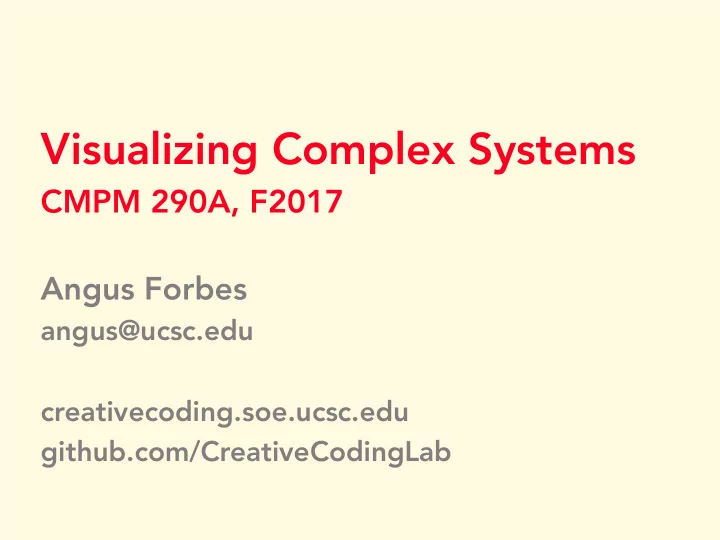

Visualizing Complex Systems CMPM 290A, F2017 Angus Forbes angus@ucsc.edu creativecoding.soe.ucsc.edu github.com/CreativeCodingLab
Beck et al., Dynamic Graph V Beck et al., Dynamic Graph Visual isualizat ization ion Fabian Beck, Michael Burch, Stephan Diehl, and Daniel Weiskopf. “A T “A Taxonomy axonomy and Survey of Dynamic Graph and Survey of Dynamic Graph Visual isualizat ization.” Computer Graphics Forum ion.” Computer Graphics Forum 36(1), 2017. 36(1), 2017.
Beck et al., Dynamic Graph V Beck et al., Dynamic Graph Visual isualizat ization ion Overview of art Overview of article: icle: - hierarchical taxonomy of techniques - classified by their representation of time - either animated - or using a timeline - challenges for future research
History of r History of resear esearch on dynamic graphs ch on dynamic graphs 1990s - A sub-problem of Graph Drawing: “node-link diagrams need to be animated without destroying the user’s mental image of the diagram” - mental map / cognitive map
History of r History of resear esearch on dynamic graphs ch on dynamic graphs 2000s – Dynamic graphs for information visualization: - special - specialized appr ized approaches for part oaches for particular icular applicat appl ication domains ion domains - al - alter ternat natives to animated node-l ives to animated node-link ink diagrams iagrams 2010s – Prolifieration of different techniques into many application domains
Animat Animation - ion - “time-to-time mapping” - dynamic stability – needed to preserve a mental map of the data - on-line vs. off-line on-line: how do organize a useful layout when you don’t know what the data will look like in the future? off-line what do you do with nodes that aren’t used in a particular time-step?
Animat Animation ion - compound graphs: where a group of similar data points is represented as a single node; where structure within the data is indicated using a hierarchical representation - animated adjacency matrix: nodes represented as items in a row/column; edges indicated as colored cells at the intersection of two nodes
Timel Timeline - ine - “time-to-space mapping” Node-link approaches: juxtaposed: copies of the nodes at each time-step are placed alongside each other superimposed: copies of the nodes at each time-step are stacked on top of each other integrated: timeline info is embedded in the node-link diagram
Timel Timeline - ine - “time-to-space mapping” Matrix-based approaches: “The challenge is to connect the spatial encoding of time with the matrix information“, but “more readable for larger and denser graphs“ intra-cell: each cell contains a timeline representation layered: matrices for each time-step are layered or juxtaposed list-based: [easier to show it]
How to evaluate? How to evaluate? Algorithmic evaluation: speed, accuracy (according to a particular layout metric) User studies: - is a user’s mental map preserved? augmented? - are people more comfortable with animation or timeline approaches?
Which appr Which approach is best oach is best? (it depends...) ? (it depends...) timeline: - quicker response time - reveals more findings over longer time periods (non-adjacent time-steps) animation: - more accurately fulfill tasks - better supports tracing of nodes + paths over time - reveals more findings between adjacent time-steps
Appl Applicat ications ions social networks: chats, online communities, blogger’s interests, interaction networks in literature, propagation of topics in tweets, ... documents (citation, topics, hyperlinks): co-authorship networks, research topics, co-citation networks, wikipedia links, ... software engineering: execution dynamics, information flow between processes, object interactions, call graphs, distributed software, author-file relationships, ... other: biological pathways, chemical reactions, gaze- tracking data, evolution of internet, communication networks, stock portfolios, geographical migration, traffic data, movie-actor relationships, ...
Resear Research Chal ch Challenges lenges Evaluation: “only a few questions have been evaluated so far. Although most efforts have concentrated on the importance of the mental map, it is only partially clear for which tasks and to what extent the mental map needs to be preserved” Visual scalability: “So far, scalability has only played a minor role in designing most dynamic graph visual- ization approaches“ Hybrids: “there are a number of hybrid variants that appear to be promising: for instance, the combination of node-link diagrams and matrices ... combinations of animation and timeline approaches have not yet been fully explored”
Resear Research Chal ch Challenges lenges Extended data d Extended data dimensions imensions: “An open question is how to visualize a hierarchical structure that changes more significantly along with the dynamic graph” + Dynamic multivariate graphs, dynamic graphs with uncertainty information, geo-located graphs, graphs representing continuous time (instead of discrete time-steps). Interaction: “Navigation in dynamic graphs can have multiple dimensions: users might navigate in space (i.e. the static graph) as well as in time.” “annotating and editing a dynamic graph structure is not well studied.” Other: new visual metaphors; comparison tasks, analytic methods for filtering/clustering; real-time data; visualizing graph dynamics (derived data); new application domains ...
Is t Is this taxonomy useful his taxonomy useful? Your next assignment is to start sketching out how you will visualize your dynamic dataset. - Is it helpful to think in terms of previous approaches? - Or is it more useful to let the data itself inspire you? - Are there enough similarities between different domains so that research in dynamic graphs is generalizable? - What is your preferred methodology for generating an effective visualization technique?
Recommend
More recommend